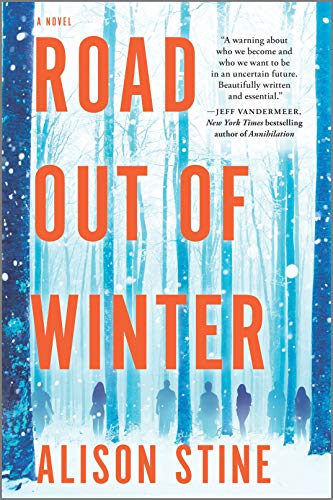
Set in the foothills of a post-apocalyptic Appalachia, Alison Stine’s Road Out of Winter is a book about desperate situations: The difficult choices they present, the bonds they help forge, and the scars they leave behind.
At its outset, the novel’s narrator and main character, Wylodine (“Wil” for short), is a 20-something marijuana grower in southeast Ohio for whom life has never been that great. Saddled with running her family’s illegal weed operation, Wil is stuck, held in place by a dysfunctional family life, economic precarity, and a general sense that fighting against life’s fate for her would be a futile endeavor.
However, this uneasy equilibrium is upended by the arrival of a seemingly never-ending winter that locks large parts of America in year-round ice and snow, forcing Wil and others to make an escape through a hellish reimagining of Appalachia more in line with Mad Max than Matewan. Along the way, Wil is forced to reckon with her past traumas, her place in the world as a woman, and the fact that her ability to grow things under the most difficult circumstances makes her a valuable target in the icy new world order.
As a work of post-apocalyptic fiction, Road Out of Winter is a riveting story that engages readers with its compelling central character and the broader themes of power, inequality, and belonging that she addresses. A pot-growing Appalachian woman from an abusive family, Wil is near the bottom of the social hierarchy and knows it. She isn’t blind to the inequalities she faces, but she can’t do much to change them. Like so many people in Appalachia, all she can do is make do with the hand she’s been dealt, with another character later in the novel summing up its philosophy well, stating, “It isn’t [what we hoped for]. But it’s where we ended up. It’s what happened.”
This stoic self-determination makes Wil an astute observer of the human condition as she and her group make their way through a veritable Gulliver’s Travels of Appalachian communities. From an anarchist skater militia to hippie eco-warriors to fundamentalist doomsday preppers, Road Out of Winter is full of diverse groups and characters that serve to both flesh out Stine’s post-apocalyptic world and provide ample opportunity for Wil to reflect on her place in a deeply unfair, patriarchal society.
It is also through these diverse groups that Stine most explicitly creates a distinctly Appalachian post-apocalyptic novel. Although its events take place across several states, at its core Road Out of Winter is a book rooted in Appalachian Ohio, the area where Stine has resided for several years and a region the book wryly describes as “the heart of nothing at all.” Most of the novel’s distinct elements seem directly inspired by southeast Ohio culture and history, and the book is at its strongest when it is most firmly grounded in these elements.

Most explicitly, “Skate State,” the anarchist skater-commune-turned-militia that serves as the book’s primary antagonistic force, is an almost one-to-one transplant of “Skatopia,” a widely covered commune in Meigs County once described as “a demented mess that meets halfway between an anarchistic Mad Maxian Thunderdome and a utopian skateboard society.” Similarly, an idealistic but probably doomed eco-warrior group (populated by well-off college-aged youth) that Wil’s group encounters seems inspired by student activists at Ohio University, where Stine has taught English courses, and their relationship with their surrounding community, one of the poorest in the United States.
However, one of Road Out of Winter’s most Appalachian characteristics, and the one that makes it especially interesting for Appalachians in the diaspora, is its prominent theme of leaving the region.
Like many young Appalachians, Wil feels stuck in the region, trapped in a dysfunctional cycle by strong feelings of attachment to family and the land until literally the apocalypse forces her to leave. Throughout the book, characters discuss what it means to leave the region and what it might mean to find a new place. Without spoiling the book’s ending, suffice it to say that Stine leaves the question of leaving open-ended enough for Appalachians and expatalachians of various backgrounds to see their journey reflected in the narrative.
One critique I can see being leveled at Road Out of Winter is the way it dials some of Appalachia’s issues up to appeal to a commercial audience—Appalachia’s poverty becomes a post-apocalyptic hellscape, its drug economy the source of its protagonist’s almost magical status as a “grower,” and the need to leave literally becomes a matter of life and death.
While there is some merit to these criticisms, Stine moves beyond stereotypes, using regional elements to create complex, multifaceted characters enmeshed in an imperfect Appalachian world. Especially given the fact that Stine lives in an impoverished rural Appalachian community and has written extensively on the struggles she and it has faced, I think her treatment of the region is generally appropriate.
So, whether you’re a fan of post-apocalyptic fiction, regional literature, or just interested in seeing the apocalypse in Athens County, check out Alison Stine’s Road Out of Winter, available now from MIRA Books.
Nicholas Brumfield is a native of Parkersburg, WV currently working in Arlington, VA. For more hot takes on Appalachia and Ohio politics, follow him on Twitter: @NickJBrumfield.
Subscribe to The Patch, our newsletter, to stay up-to-date with new expatalachians articles and news from around Appalachia.


